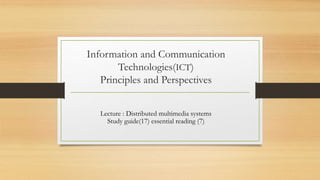Multimedia networks
•Download as PPTX, PDF•
0 likes•15 views
RTP is a protocol for transporting real-time multimedia data like audio and video over IP networks. It works with RTCP for feedback on data delivery. RTP packet headers include fields for payload type identification, sequence numbering, timestamps, and SSRC for stream source identification. SIP establishes and manages multimedia sessions and calls over IP, allowing participants to negotiate media encodings and manage calls through actions like adding streams, changing encoding, or inviting others. SIP messages are ASCII text sent over UDP or TCP and it requires message acknowledgment.
Report
Share
Report
Share

Recommended
Recommended
More Related Content
What's hot
What's hot (20)
An overview of TCP (Transmission Control Protocol)

An overview of TCP (Transmission Control Protocol)
RTSP Protocol - Explanation to develop API of RTSP Protocol

RTSP Protocol - Explanation to develop API of RTSP Protocol
Similar to Multimedia networks
Similar to Multimedia networks (20)
CCNA (R & S) Module 01 - Introduction to Networks - Chapter 9

CCNA (R & S) Module 01 - Introduction to Networks - Chapter 9
More from Saqib Shehzad
More from Saqib Shehzad (20)
Cognition, information processing, perception and attention

Cognition, information processing, perception and attention
Recently uploaded
Recently uploaded (20)
Simple, Complex, and Compound Sentences Exercises.pdf

Simple, Complex, and Compound Sentences Exercises.pdf
Introduction to TechSoup’s Digital Marketing Services and Use Cases

Introduction to TechSoup’s Digital Marketing Services and Use Cases
21st_Century_Skills_Framework_Final_Presentation_2.pptx

21st_Century_Skills_Framework_Final_Presentation_2.pptx
HMCS Max Bernays Pre-Deployment Brief (May 2024).pptx

HMCS Max Bernays Pre-Deployment Brief (May 2024).pptx
Sensory_Experience_and_Emotional_Resonance_in_Gabriel_Okaras_The_Piano_and_Th...

Sensory_Experience_and_Emotional_Resonance_in_Gabriel_Okaras_The_Piano_and_Th...
Transparency, Recognition and the role of eSealing - Ildiko Mazar and Koen No...

Transparency, Recognition and the role of eSealing - Ildiko Mazar and Koen No...
On National Teacher Day, meet the 2024-25 Kenan Fellows

On National Teacher Day, meet the 2024-25 Kenan Fellows
Python Notes for mca i year students osmania university.docx

Python Notes for mca i year students osmania university.docx
Multimedia networks
- 1. Information and Communication Technologies(ICT) Principles and Perspectives Lecture : Distributed multimedia systems Study guide(17) essential reading (7)
- 2. Protocols for real time apps
- 3. Real Time protocol • Real Time protocol ( RTP ) • can be used for transporting common formats such as PCM, ACC, and MP3 for sound and MPEG and H.263 for video • Packet structure for carrying audio/video data • RTP provides • Payload identification • Packet sequence numbering • Time stamping
- 4. Real Time protocol ( RTP ) • RTP packet has UDP segment and media chunk • RTP is for end systems only, intermediate routes don’t examine it • RTP in end systems and RTP libraries provides transport layer interface that extends UDP with • Port numbers, IP address • payload type identification • packet sequence numbering • time-stamping.
- 5. RTP packet header • Version • Padding • Extension • CSRC count (CC) • Marker
- 6. RTP headers • Synchronization source identifier (SSRC). The SSRC field is 32 bits long. It identifies the source of the RTP stream. Typically, each stream in an RTP session has a distinct SSRC. • The SSRC is not the IP address of the sender, but instead is a number that the source assigns randomly when the new stream is started. • The probability that two streams get assigned the same SSRC is very small. Should this happen, the two sources pick a new SSRC value
- 7. Real-Time Control Protocol (RTCP) • Used in combination with RTP • All participants send reports periodically to all others , number of packets lost/sent, inter arrival jitter. Timestamps at receiver Vs RTP media timestamps etc. • Scaling issue is in multicasting. Too many packets by receivers • RTCP modifies the rate with which participants send traffic into the multicast tree as a function of the number of participants in the session
- 8. Session Initiation protocol (SIP) • Mechanisms for establishing calls over an IP network. • Allows the caller to notify the callee that it wants to start a call. • Allows the participants to agree on media encodings. • Allows participants to end calls. • Mechanisms for the caller to determine the current IP address of the callee. • Users do not have a single, fixed IP address because they may be assigned addresses dynamically (using DHCP) and because they may have multiple IP devices, each with a different IP address.
- 9. Session Initiation protocol (SIP) • Mechanisms for call management • such as adding new media streams during the call • changing the encoding during the call • inviting new participants during the call • call transfer, call holding.
- 11. Key Characteristics of SIP • First, SIP is an out-of-band protocol: The SIP messages are sent and received in sockets that are different from those used for sending and receiving the media data. • Second, the SIP messages themselves are ASCII-readable and resemble HTTP messages. • Third, SIP requires all messages to be acknowledged, so it can run over UDP or TCP
- 12. Scenarios • Bob doesn’t have proper codec • Will send list of available codecs, Alice will choose one and resend invite with that codec • Busy • Gone • Payment required • Forbidden etc.
- 13. SIP • IP not known to Alice • Will send request on email id like bob@domain.com • SIP Proxy will respond with IP address of Bob or voicemail box or a URL saying Bob is sleeping • SIP registrar. • Every SIP user has an associated registrar. Whenever a user launches an SIP application on a device, the application sends an SIP register message to the registrar, informing the registrar of its current IP address
Editor's Notes
- http://ritzinmobileworld.blogspot.com/2014/07/rtp-basics-part-ii-rtp-packet-structure.html
- Session initiation, involving SIP proxies and registrars